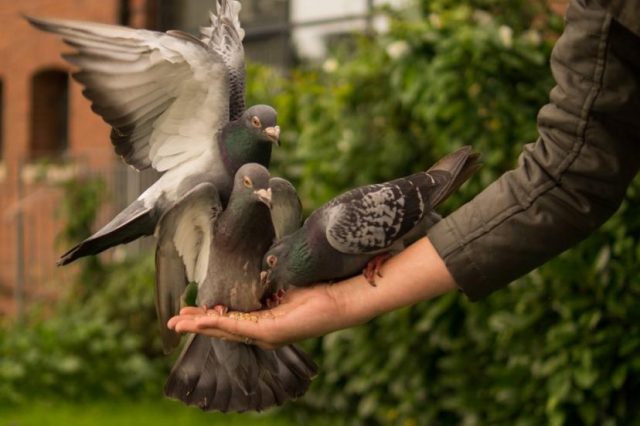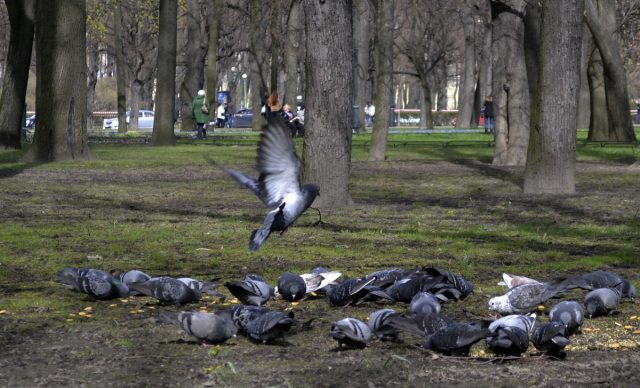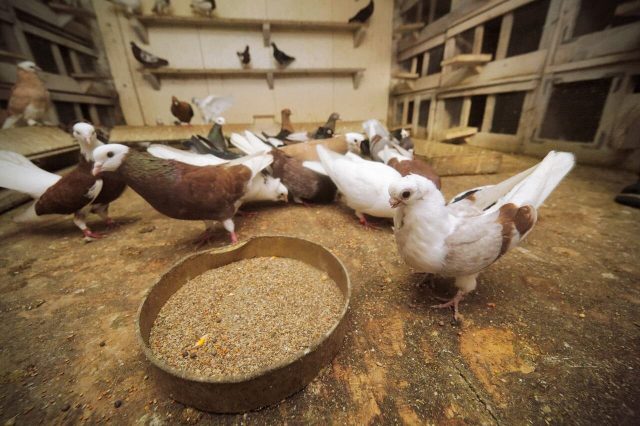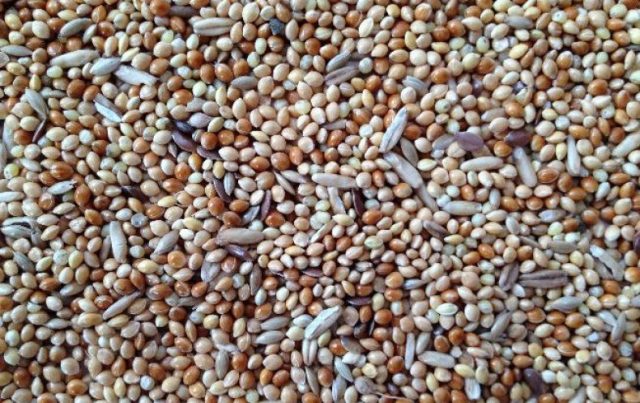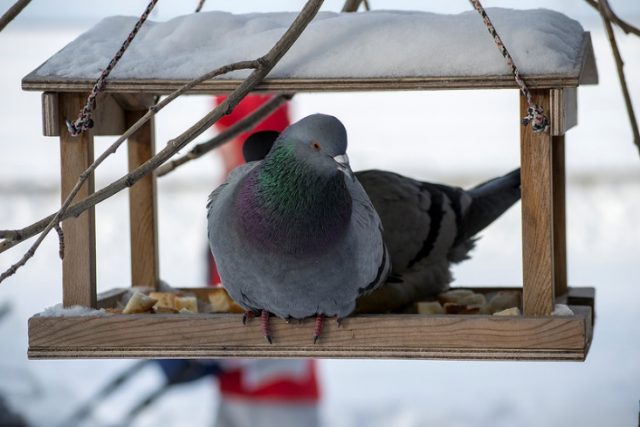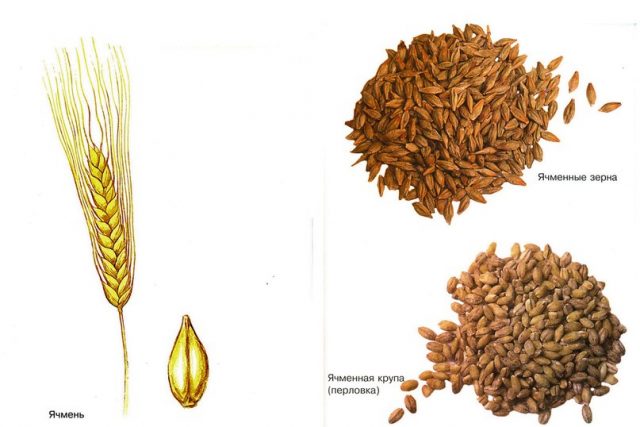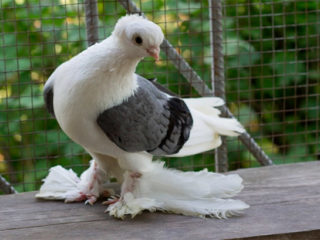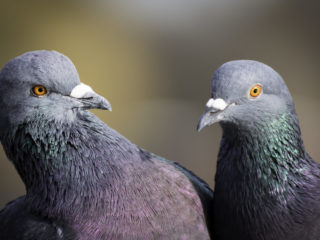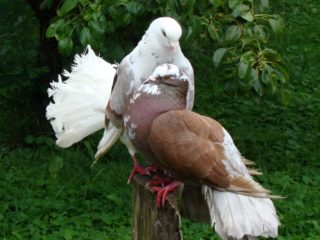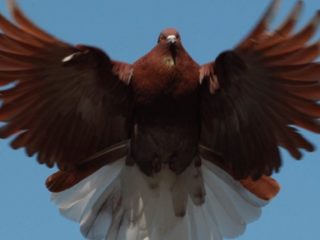Content
- 1 What does a pigeon eat?
- 2 Where to feed pigeons
- 3 How often to feed pigeons
- 4 How to feed pigeons correctly
- 5 What to feed pigeons at home
- 6 Feed additives
- 7 What can you feed pigeons outside in winter?
- 8 What to feed a wounded pigeon
- 9 FAQ
- 9.1 Is it possible to feed pigeons bread?
- 9.2 Is it possible to feed pigeons buckwheat?
- 9.3 Is it possible to feed pigeons pearl barley?
- 9.4 Is it possible to feed pigeons rice?
- 9.5 Is it possible to feed pigeons peas?
- 9.6 Is it possible to feed pigeons seeds?
- 9.7 Is it possible to feed pigeons oatmeal?
- 9.8 Is it possible to feed pigeons oats?
- 10 What not to feed pigeons
- 11 Conclusion
Feeding pigeons has become one of the pleasant traditions in modern parks, squares and courtyards. Beautiful birds in urban environments need feeding, and people happily sprinkle them with seeds, crumble bread, and buns. Few people think about whether it is right to offer such food to pigeons and whether it will harm them. It is especially important to find out a diet that is beneficial for birds before purposefully breeding them.
What does a pigeon eat?
Pigeons are not omnivores. Living in cities, they have to be content with any food waste and nutrition provided by humans.But the bird’s stomach, designed to digest completely different food, quickly fails. City pigeons live for about 3 seasons and die not from hunger, but from indigestion, when the stomach is not able to digest abundant but unsuitable food.
In nature, the diet of pigeons is simple - any grains, seeds, small nuts and greens. Of particular value for nutrition are the flowering tops of herbs or baskets with seeds. City grass is regularly mowed and trees and bushes are pruned, so birds have to make do with what humans offer.
By raising birds at home, it is possible to feed them in a balanced manner. Taking into account the needs of pigeons as much as possible, the active life span can realistically be extended to 15-20 years. It is not difficult to feed domesticated birds varied and healthy. The diet does not contain exotic or hard-to-find foods. It’s worth thinking about healthy food for pigeons, even just when going for a walk in a city park.
Where to feed pigeons
If everything is clear with poultry - it is customary to feed it in a dovecote or from feeders on the street, then with city birds everything is not so clear. Feeding entire flocks in a square or playground is romantic in appearance and very popular with children, but there is another side to the process.
Pigeons are easy to train. By starting to feed them periodically in one place, you can guarantee the regular arrival of a huge number of birds. Such places will very soon be marked with layers of droppings, which will make walking with children more problematic, and playgrounds and sidewalks less well-groomed.
Therefore, it is better to feed pigeons in the city, following several rules:
- Birds are fed where their accumulation will not cause inconvenience: on lawns, in plantings, parks where there is no active pedestrian traffic, playgrounds.
- To feed pigeons, they use special birdseed, cereals, grains, apples, and leafy vegetables. Avoid baked goods and other foods that are unusual for birds.
- After contact with birds, be sure to wash your hands, as after interacting with any stray animals.
You can even feed city pigeons, accustomed to human attention, by hand. Few people can resist the temptation to offer grains to a bird directly from the palm of their hand.
How often to feed pigeons
How often to feed poultry depends on the season. In different seasons, the nutritional needs of pigeons are different. Meal times are selected according to the length of the day.
The mobility of poultry in cold weather is limited; they spend most of the day in special rooms. In winter, pigeons should be fed no more than 2 times a day, preferably during daylight hours. The first time - no earlier than 8 o'clock in the morning, the second time - before sunset, or no later than 18.00. The onset of the warm season requires feeding your pets 3 times a day. The period of feeding the offspring will require strict adherence to an 8-hour interval: around 5 am, at 1 pm and no later than 9 pm.
Feeding in summer and autumn should be kept in mind that birds fly most of the day, getting their own food. It is possible to limit yourself to complementary feeding, sometimes filling the feeders.
How to feed pigeons correctly
For the full development of breeding pigeons and obtaining healthy offspring, it is important not only what to feed the birds, but also how to do it correctly.
Basic principles:
- The small volume of the stomach requires fractional nutrition. It is not enough to feed domestic pigeons enough once a day.
- You should roughly calculate the amount of food based on the size of the birds, their activity and the season. Domestic pigeons do not benefit from being over-fed or force-fed. Lack of appetite may indicate illness or lack of vitamins.
- Between feedings, feeders should be cleared of old food and the floor of the dovecote should be swept. Pecking of stale food from the floor is the main cause of illness in poultry.
- It is unacceptable to feed pigeons human kitchen waste. Porridge for birds is prepared separately.
- Even the most balanced diet of cereals and greens is not enough for a domestic pigeon. Vitamin and mineral supplements will be required.
The approximate serving size for one adult light breed bird is from 20 to 30 g per day. Large individuals of heavy breeds will need to be fed twice as much.
What to feed pigeons at home
The bird diet is compiled according to a general scheme, where there are mandatory items and parts that can be replaced.
Basic principles of formulating food for pigeons:
- 40% of the grain portion is allocated to barley; if necessary, it is briefly replaced with pearl barley;
- 30% of the diet – wheat;
- 10% of the feed is millet.
The remaining components are added arbitrarily:
- legumes: lentils, peas (yellow), beans, vetch;
- oilseeds: hemp, rapeseed, sunflower, flax;
- rolled oats or whole oats;
- raw cereals and porridges made from them.
Be sure to add greens to your diet every day: fresh or dried grass, berries (can be dried), chopped cabbage, apples, raw or cooked seasonal vegetables.
What can you feed pigeons in winter?
The diet in cold weather is changed based on the low mobility of birds. Pigeons should be fed less frequently (twice a day); birds respond well to boiled foods: potatoes, cereals, vegetables. Greens are replaced by dried herbs, dill, parsley, alfalfa.
Pigeons should be fed at home in winter by reducing the proportion of protein in the composition. This is how the sexual activity of birds is regulated, preventing untimely laying of eggs. To do this, exclude legumes from the mixtures and reduce the proportion of wheat. Replenish the diet with oats or barley.
Some grains are completely replaced with boiled vegetables (for example, potatoes), mixing them with bran. Closer to spring, they begin to feed with an increasing proportion of oilseeds, and 2 weeks before the expected mating, they begin to feed hemp seed.
What to feed domestic pigeons in spring
The approach of spring allows you to feed the pigeons, returning to the standard pattern. Be sure to add special preparations of vitamins and microelements to your diet.
Especially important for birds:
- copper;
- manganese;
- iron;
- potassium;
- zinc;
- cobalt.
If not enough elements are supplied with food, the shells of eggs become thin, the growth of chicks slows down, and the bones and ligaments in adults are weakened.
The presence of all microelements in pharmaceutical preparations purchased for pigeons should be checked. Phosphorus, sodium, calcium must be added additionally; these macroelements are especially necessary. In spring, poultry are often fed grated carrots, apples, and pumpkins. It is important to monitor the rate of feed intake.Overeating, pigeons become lethargic and begin to get sick.
What is the best way to feed pigeons in summer?
During the period when birds move a lot and spend more energy, their feeding behavior should be closely monitored. During daily flights, pigeons can find food on their own. If the birds eat less than usual, then three meals a day will not be required. Pigeons should be fed moderately, mainly peas, buckwheat, millet, rapeseed, and vetch.
If there are no decent food sources nearby and the birds return hungry, the ration is left complete, three times a day. In hot weather, birds drink a lot, so water should be added more often.
What can you feed a pigeon at home in the fall?
From July, most pigeons begin to molt; this period will last until late autumn. Birds need to be fed taking into account their increased need for protein. Usually the proportion of legumes is increased, but wheat is completely removed due to the danger of provoking sexual activity.
To stimulate the growth of new feathers, pigeons need sulfur. Birds should be fed with mineral supplements, adding cobalt sulfate monthly. There are special sulfur-based preparations created for feeding pigeons during feather change.
Feeding pigeons during the breeding season
Protein feeds are most suitable for this period. The daily rate is increased to 60 g per bird, and the proportion of wheat and peas is increased. Pigeons in the dovecote are fed mainly with wet cereal mixtures, seasoned with sour milk or skim milk.
Before laying, it is appropriate to feed the birds with sprouted grain and add mineral supplements with calcium and phosphorus. Be sure to discuss vitamin A supplements suitable for pigeons with your veterinarian. This substance directly affects the intensity of the masonry. Vitamin B2, which is responsible for the survival of the embryo, is found in sprouted grains. With the onset of the breeding season, the share of such grain must be increased to 10%.
Feed additives
Mandatory complementary foods include fresh or dried greens. You can grow grass yourself or mow it in places that are not subject to chemical pollution, far from highways and factories.
Natural materials are used as mineral additives:
- ground shells;
- charcoal;
- brick chips;
- old lime;
- coarse river sand;
- dried egg shells.
Pigeons should be fed boiled cereals or vegetables with the obligatory addition of salt. This is a necessary ingredient in a balanced diet for birds, but exceeding the norm is dangerous for their health. The salt concentration is calculated based on 10 g (1 tsp) of product per 500 ml of water. When feeding dry cereals, salt should be added to the drinking bowl regularly. Whole crystals burn the crop of birds, so they feed the food completely dissolved.
Insufficient intake of vitamins or minerals is indicated by lethargy of pigeons, loss of appetite, ruffled or dull feathers, and diarrhea. It is especially important to use supplements during breeding, feeding chicks and molting.
What can you feed pigeons outside in winter?
The best option for feeding wild pigeons is to hang special feeders on trees: in public gardens, parks, and on small green islands.Regularly filling containers with foods that are healthy for birds, eliminates the need for them to look for food in trash containers and landfills.
In winter, outdoor birds especially need energy to stay warm and fly. And the only suitable food left are rare bushes and trees with frozen berries. Therefore, it is especially appropriate to feed pigeons in winter. Any cereal is suitable for filling feeders, but pearl barley, wheat, and buckwheat are the best and healthiest.
What to feed a wounded pigeon
A weakened body needs increased nutrition to recover. But it often happens that a wounded bird has no appetite. Instead of trying to force feed, you should start by taking a multivitamin. For birds it is convenient to use drop forms. Vitamins are dripped directly into the beak or added to the water.
A few drops of vitamin preparations can completely change the situation. In a few days, the appetite will be restored and the bird can be fed fully, based on the described schemes. Until recovery and wound healing, nutrition is enhanced, with the obligatory addition of sprouted grains and herbs.
If the injury is serious and requires veterinary intervention, the specialist will advise the necessary medications. In any other case, it is permissible to feed a wounded bird with specialized food for parrots and vitamin complexes for birds from a pet store.
FAQ
Those who have never encountered professional pigeon breeding have a lot of questions when it comes to the need to breed a randomly selected bird.It is necessary to clarify some features for feeding street pigeons, and especially for breeding in an equipped dovecote.
Is it possible to feed pigeons bread?
Products baked from flour using yeast are absolutely not intended for birds. The high salt content and the ability to ferment in the stomach stop the digestion process, making it impossible to fully process even healthy “bird” food.
Thus, the pigeon’s body receives little energy. This condition is especially dangerous in winter. This threatens the bird with hypothermia and death. You should not feed pigeons with white bread either in the dovecote or on the street. Brown bread is even more harmful to birds due to the presence of gluten.
Is it possible to feed pigeons buckwheat?
It is permissible to mix cereals with grain feed, cook porridge, and steam them with bran. Buckwheat is good for birds in any form. With enhanced nutrition in spring and summer, the amount of cereal can be increased to 5% of the total diet. Unrefined buckwheat grain is useful to feed pigeons in the spring, but it is worth limiting the amount of such complementary food due to the hard pericarp.
Is it possible to feed pigeons pearl barley?
Barley is the basis of a healthy diet for domestic pigeons. Pearl barley, as a cereal made from processed barley, can temporarily replace it. Boiled cereal is offered to chicks whose food is not yet sufficiently digested in the crop. It is also acceptable to feed street pigeons with store-bought pearl barley.
Is it possible to feed pigeons rice?
Regular white or unrefined brown grains are used as an addition to dry mixtures. Boiled rice cereal with crushed chalk is administered as a food supplement or medicine for indigestion. But if you feed pigeons rice and cereals made from it for a long time, then the birds may develop nervous system disorders.
Is it possible to feed pigeons peas?
Peas, like other legumes, are an excellent source of protein for birds. The amount of yellow, crushed peas in the diet should not exceed 10% during the main period, drop to 5% in winter and increase to 20% during the breeding season.
It is useful to feed pigeons legumes during transportation, feeding chicks and during molting. A long-term increase in the proportion of protein feed in the absence of active flights can lead to obesity in birds.
Is it possible to feed pigeons seeds?
Sunflower seeds are a valuable product in the diet of birds. Oily grains supply the pigeon’s body with essential fatty acids, and the hard peel contains a lot of useful microelements. Raw seeds can be used as a supplement and sometimes as a dietary staple. Dull plumage and untimely molting are a signal to add oilseeds to the feed.
Is it possible to feed pigeons oatmeal?
The processed product is easily digestible; the flattened grains can be useful for feeding weakened, sick birds and feeding young animals. If necessary, oat flakes can be used to replace up to 50% of the total feed for a short time. You should not overuse foods that are easy to digest. The pigeon's crop and stomach require constant stress and require rigid components.
Is it possible to feed pigeons oats?
Unrefined raw materials with husks are more suitable for bird nutrition than flakes. Seeded oats contain a lot of fiber, coarse fibers, and the fruit part is easily absorbed by the body. But only large species of pigeons can be fed with such grain.
It is recommended to give half of the unrefined oats in the diet after steaming. To do this, boil the grain for 10 minutes, strain the oats and dry them a little. For cooking, water should be added at the usual rate.
What not to feed pigeons
There are still quite strict restrictions in the diet of birds that are unpretentious and resistant to different conditions:
- Bread (black, white, yeast-free), baked goods, sweet, salty, fried dough. As a last resort, it is permissible to feed the pigeons white crumbled breadcrumbs.
- Fermented milk products and cottage cheese help flush out calcium from the bird’s body.
- Fish and any seafood, shellfish, snails.
- Meat in any form.
Several types of feed can be used on a limited basis. Seeds are offered exclusively to large individuals and are fed with seeds in small quantities due to the hard, poorly digestible shell.
Millet is an excellent product suitable for all types of birds, but you can feed pigeons with millet only as a last resort. In the grain peeled from the shell, oxidation processes quickly begin. Over time, there are fewer beneficial substances than harmful ones. It is better to feed poultry not with millet, but with whole, unpeeled millet grains.
Conclusion
Feeding pigeons seems like a noble and fairly simple task. But, without knowing the digestive characteristics of birds, it is easy to harm them.Beautiful domestic pigeons with shiny feathers, characterized by increased strength and endurance, are the result of the painstaking work of their owners, who provided the birds with excellent care and balanced nutrition.
